Evaluation of Implementation of Biomass and Solar Resources by Energy Systems in the Coal-Mining Areas of Spain
Abstract
:1. Introduction
2. Materials and Methods
2.1. Research of Biomass and Solar Energy
2.2. Study Area
2.3. Multiphase Mathematical Model
2.3.1. Phase I: Biomass and Solar Energy Resources
- m: total available mass (dry t/year).
- mi: total available mass of conifers, hardwood, and mixtures (dry t/year).
- E: energy from available mass (GJ/year).
- mi: total available mass of conifers, hardwood, and mixtures (dry t/year).
- LHVi: Lower Heating Value of conifers, hardwood, and mixtures (GJ/dry t).
2.3.2. Phase II: Thermo-Energetic Conversion
- Ac = Area of solar collector area (m2).
- F′R = Collector-heat exchanger efficiency factor (%).
- FR = Collector heat removal factor (%).
- UL = Collector overall energy loss coefficient (W/m2·°C).
- Δt = Total number of seconds in the month.
- = Monthly average ambient temperature (°C).
- Tref = Empirical reference temperature (°C).
- = Monthly average daily radiation incident on collector surface per unit area (J/m2).
- L = Monthly total heating load for space heating and hot water (J).
- N = Number of days per month.
- = Normal transmittance–absorptance product (%).
- (τα) = Monthly average transmittance–absorptance product (%).
2.3.3. Phase III: Energy Management
3. Results
4. Discussion
5. Conclusions
- The potential biomass resources vary from 100 to 340 dry kt/year with an availability of 40% in the study area. The total available biomass resources are equivalent to 11,400 TJ/year. Additionally, the study area shows an average daily solar radiation of 14 MJ/m2. Under such conditions, the available resources are sufficient for the proposed energy system.
- Thermal energy is shown as efficient energy conversion in energy systems. A proposed hybrid-modular system combines solar and biomass energy with a techno-economic sustainable manner to produce 250 kWth with 70% of bioenergy supply equivalent to 20,000 L/day as DHW at 60 °C for DHS. The F-factors analysis by “f-method-p” shows an Fs minimum average value of 0.2 per month throughout the year. Meanwhile, Fb and Fb/s average parameters can be up to 0.8 and 3.6 in the same period.
- The hybrid-modular system could avoid a coal consumption of 70 t/year, and up to 230 t CO2/year, 3 t NO2/year, and 1 t SO2/year can be avoided per system considering a total chemical conversion, by combustion, of coal into these types of emissions.
- The theoretical total hybrid-modular systems to implement in all the sectors of the study area (Figure 1) are 4661 units equivalent to 1165 MWth and supply thermal energy for 170,000 single-family houses, which could create 28,050 job-years.
Author Contributions
Funding
Acknowledgments
Conflicts of Interest
References
- Kumar, A.; Sah, B.; Singh, A.R.; Deng, Y.; He, X.; Kumar, P.; Bansal, R.C. A review of multi criteria decision making (MCDM) towards sustainable renewable energy development. Renew. Sustain. Energy Rev. 2017, 69, 596–609. [Google Scholar] [CrossRef]
- Stanislav, Y.; Anton, T.; Nikolay, B.; Vladimir, G. Justification of the Energy Use of Cedar Husk Waste as an Environmentally Friendly Additive for Co-Combustion with Coal. Energies 2021, 14, 7027. [Google Scholar] [CrossRef]
- Arribas, L.; Lechón, Y.; Perula, A.; Domínguez, J.; Ferres, M.; Navarro, J.; Zarzalejo, L.F.; García Barquero, C.; Cruz, I. Review of Data and Data Sources for the Assessment of the Potential of Utility-Scale Hybrid Wind–Solar PV Power Plants Deployment, under a Microgrid Scope. Energies 2021, 14, 7434. [Google Scholar] [CrossRef]
- Yankovsky, S.A.; Kuznetsov, G.V.; Tolokolnikov, A.A.; Cherednik, I.V.; Ivanov, A.A. Experimental study of the processes of reducing the formation of sulfur oxides during the co-combustion of particles of metalignitous coal and wood processing waste. Fuel 2021, 291, 120233. [Google Scholar] [CrossRef]
- Paredes-Sánchez, B.M.; Paredes-Sánchez, J.P.; García-Nieto, P.J. Energy Multiphase Model for Biocoal Conversion Systems by Means of a Nodal Network. Energies 2020, 13, 2728. [Google Scholar] [CrossRef]
- Saint-Marc, R.; Paredes-Sánchez, J.P.; Xiberta-Bernat, J. Power Generation from Bioenergy Crops by Technical and Economic Feasibility Assessment. Proceedings 2018, 2, 1476. [Google Scholar] [CrossRef] [Green Version]
- Paredes-Sánchez, J.P.; Las-Heras-Casas, J.; Paredes-Sánchez, B.M. Solar Energy, the Future Ahead. In Advances in Sustainable Energy. Lecture Notes in Energy; Vasel-Be-Hagh, A., Ting, D., Eds.; Springer: Cham, Switzerland, 2019; Volume 70, pp. 113–132. [Google Scholar]
- Burguet-Fernández, G.; Paredes-Sánchez, J.P.; Xiberta-Bernat, J. Bioenergy Valuation of Poultry Litter by Applying an Enzyme Product for Environmental Purposes: A New Applied Technology. Proceedings 2018, 2, 1480. [Google Scholar] [CrossRef] [Green Version]
- Soutullo, S.; Giancola, E.; Sánchez, M.N.; Ferrer, J.A.; García, D.; Súarez, M.J.; Prieto, J.I.; Antuña-Yudego, E.; Carús, J.L.; Fernández, M.Á.; et al. Methodology for Quantifying the Energy Saving Potentials Combining Building Retrofitting, Solar Thermal Energy and Geothermal Resources. Energies 2020, 13, 5970. [Google Scholar] [CrossRef]
- Paredes-Sánchez, J.P.; Conde, M.; Gómez, M.A.; Alves, D. Modelling hybrid thermal systems for district heating: A pilot project in wood transformation industry. J. Clean. Prod. 2018, 194, 726–734. [Google Scholar] [CrossRef]
- Lake, A.; Rezaie, B.; Beyerlein, S. Review of district heating and cooling systems for a sustainable future. Renew. Sustain. Energy Rev. 2017, 67, 417–425. [Google Scholar] [CrossRef]
- Benedek, J.; Sebestyén, T.T.; Bartók, B. Evaluation of renewable energy sources in peripheral areas and renewable energy-based rural development. Renew. Sustain. Energy Rev. 2018, 90, 516–535. [Google Scholar] [CrossRef]
- Mohammadi, K.; Khanmohammadi, S.; Khorasanizadeh, H.; Powell, K. A comprehensive review of solar only and hybrid solar driven multigeneration systems: Classifications, benefits, design and prospective. Appl. Energy 2020, 268, 114940. [Google Scholar] [CrossRef]
- Mahmoud, M.; Ramadan, M.; Naher, S.; Pullen, K.; Olabi, A.G. The impacts of different heating systems on the environment: A review. Sci. Total Environ. 2020, 766, 142625. [Google Scholar] [CrossRef]
- Fernández, S.T.; Sánchez, J.P.P.; Trashorras, A.J.G. Analysis of forest residual biomass potential for bioenergy production in Spain. Clean Technol. Environ. Policy 2016, 18, 209–218. [Google Scholar]
- Ma, Z.; Knotzer, A.; Billanes, J.D.; Jørgensen, B.N. A literature review of energy flexibility in district heating with a survey of the stakeholders’ participation. Renew. Sustain. Energy Rev. 2020, 123, 109750. [Google Scholar] [CrossRef]
- Mouaky, A.; Rachek, A. Thermodynamic and thermo-economic assessment of a hybrid solar/biomass polygeneration system under the semi-arid climate conditions. Renew. Energy 2020, 156, 14–30. [Google Scholar] [CrossRef]
- Díaz-Cuevas, P.; Domínguez-Bravo, J.; Prieto-Campos, A. Integrating MCDM and GIS for renewable energy spatial models: Assessing the individual and combined potential for wind, solar and biomass energy in Southern Spain. Clean Technol. Environ. Policy 2019, 21, 1855–1869. [Google Scholar] [CrossRef]
- Higueras-Castillo, E.; Munoz-Leiva, F.; Liébana-Cabanillas, F.J. An examination of attributes and barriers to adopt biomass and solar technology. A cross-cultural approach. J. Environ. Manag. 2019, 236, 639–648. [Google Scholar] [CrossRef] [PubMed]
- Hussain, C.I.; Norton, B.; Duffy, A. Technological assessment of different solar-biomass systems for hybrid power generation in Europe. Renew. Sustain. Energy Rev. 2017, 68, 1115–1129. [Google Scholar] [CrossRef] [Green Version]
- Zhang, L.; Li, F.; Sun, B.; Zhang, C. Integrated optimization design of combined cooling, heating, and power system coupled with solar and biomass energy. Energies 2019, 12, 687. [Google Scholar] [CrossRef] [Green Version]
- Sahoo, U.; Kumar, R.; Singh, S.K.; Tripathi, A.K. Energy, exergy, economic analysis and optimization of polygeneration hybrid solar-biomass system. Appl. Therm. Eng. 2018, 145, 685–692. [Google Scholar] [CrossRef]
- Igogo, T.; Lowder, T.; Engel-Cox, J.; Awuah-Offei, K.; Newman, A.M. Integrating Clean Energy in Mining Operations: Opportunities, Challenges, and Enabling Approaches (No. NREL/TP-6A50-76156); National Renewable Energy Lab. (NREL): Golden, CO, USA, 2020; p. 43. [Google Scholar]
- Michalski, J.; Bünger, U.; Crotogino, F.; Donadei, S.; Schneider, G.S.; Pregger, T.; Cao, K.; Heide, D. Hydrogen generation by electrolysis and storage in salt caverns: Potentials, economics and systems aspects with regard to the German energy transition. Int. J. Hydrog. Energy 2017, 42, 13427–13443. [Google Scholar] [CrossRef]
- Paredes-Sánchez, J.P.; López-Ochoa, L.M.; López-González, L.M.; Xiberta-Bernat, J. Bioenergy for District Bioheating System (DBS) from eucalyptus residues in a European coal-producing region. Energy Convers. Manag. 2016, 126, 960–970. [Google Scholar] [CrossRef]
- Paredes-Sánchez, J.P.; Míguez, J.L.; Blanco, D.; Rodríguez, M.A.; Collazo, J. Assessment of micro-cogeneration network in European mining areas: A prototype system. Energy 2019, 174, 350–358. [Google Scholar] [CrossRef]
- Daioglou, V.; Doelman, J.C.; Wicke, B.; Faaij, A.; van Vuuren, D.P. Integrated assessment of biomass supply and demand in climate change mitigation scenarios. Glob. Environ. Change 2019, 54, 88–101. [Google Scholar] [CrossRef] [Green Version]
- Wang, J.; Han, Z.; Guan, Z. Hybrid solar-assisted combined cooling, heating, and power systems: A review. Renew. Sustain. Energy Rev. 2020, 133, 110256. [Google Scholar] [CrossRef]
- Liu, M.; van Dam, K.H.; Pantaleo, A.M.; Guo, M. Optimisation of integrated bioenergy and concentrated solar power supply chains in South Africa. Comput.-Aided Chem. Eng. 2018, 43, 1463–1468. [Google Scholar]
- Bahlawan, H.; Morini, M.; Pinelli, M.; Poganietz, W.; Spina, P.; Venturini, M. Optimization of a hybrid energy plant by integrating the cumulative energy demand. Appl. Energy 2019, 253, 113484. [Google Scholar] [CrossRef]
- Wang, J.; Yang, Y. Energy, exergy and environmental analysis of a hybrid combined cooling heating and power system utilizing biomass and solar energy. Energy Convers. Manag. 2016, 124, 566–577. [Google Scholar] [CrossRef]
- Srinivas, T.; Reddy, B.V. Hybrid solar–biomass power plant without energy storage. Case Stud. Therm. Eng. 2014, 2, 75–81. [Google Scholar] [CrossRef] [Green Version]
- IRMC (Instituto Para la Reestructuración de la Minería del Carbón y de las Cuencas Mineras). Marco de Actuación para la Minería del Carbón y las Comarcas Mineras en el Periodo 2013–2018; IRMC: Madrid, Spain, 2014; p. 34. (In Spanish) [Google Scholar]
- MINETUR (Ministerio de Industria, Energía y Turismo). Orden IET/1158/2014, de 30 de Junio, por la que se Aprueban las Bases Reguladoras para la Concesión de Ayudas Dirigidas a Proyectos Empresariales Generadores de Empleo, que Promuevan el Desarrollo Alternativo de las Zonas Mineras, para el Período 2014–2018; Ministerio de Industria, Energía y Turismo: Madrid, Spain, 2014. (In Spanish)
- Raluy, R.G.; Guillén-Lambea, S.; Serra, L.M.; Guadalfajara, M.; Lozano, M.A. Environmental assessment of central solar heating plants with seasonal storage located in Spain. J. Clean Prod. 2021, 314, 128078. [Google Scholar] [CrossRef]
- Paredes-Sánchez, B.M.; Paredes, J.P.; Caparrini, N.; Rivo-López, E. Analysis of District Heating and Cooling Energy Systems in Spain: Resources, Technology and Management. Sustainability 2021, 13, 5442. [Google Scholar] [CrossRef]
- Van Holsbeeck, S.; Srivastava, S.K. Feasibility of locating biomass-to-bioenergy conversion facilities using spatial information technologies: A case study on forest biomass in Queensland, Australia. Biomass Bioenergy 2020, 139, 105620. [Google Scholar] [CrossRef]
- Omar, R.C.; Wahab, W.A.; Putri, R.F.; Roslan, R.; Baharuddin, I.N.Z. Solar suitability map for office buildings using integration of remote sensing and Geographical Information System (GIS). In IOP Conference Series: Earth and Environmental Science; IOP Publishing: Bristol, UK, 2020; Volume 451, p. 012032. [Google Scholar]
- Bergman, P.C.A.; Boersma, A.R.; Zwart, R.W.R.; Kiel, J.H.A. Torrefaction for Biomass Co-Firing in Existing Coal-Fired Power Stations; ECN (Energy Research Centre of the Netherlands): Petten, The Netherlands, 2005; pp. 1–71. [Google Scholar]
- Avtar, R.; Sahu, N.; Aggarwal, A.K.; Chakraborty, S.; Kharrazi, A.; Yunus, A.P.; Dou, J.; Kurniawan, T.A. Exploring Renewable Energy Resources Using Remote Sensing and GIS—A Review. Resources 2019, 8, 149. [Google Scholar] [CrossRef] [Green Version]
- PVGIS. Solar Energy Database. Available online: https://re.jrc.ec.europa.eu/pvg_tools/es/#MR (accessed on 10 June 2021).
- Censolar. Solar Technical Resources and Data. Available online: https://www.censolar.org/energia-solar/ (accessed on 10 June 2021). (In Spanish).
- Campus virtual. In La Energía Solar Térmica. Manual de Prácticas de Tecnología Energética (In Spanish), Database Solar for Practise Material; Universidad de Oviedo: Oviedo, Asturias, Spain, 2021.
- BIORAISE. GIS Biomass Resources Database. Available online: http://bioraise.ciemat.es/Bioraise (accessed on 10 June 2021).
- Esteban, L.S.; Carrasco, J.E. Biomass resources and cost: Assessment in different EU countries. Biomass Bioenergy 2011, 35, S21–S30. [Google Scholar] [CrossRef]
- MITECO (Ministerio para la Transición Ecológica y el Reto Demográfico). Plan de Energías Renovables (PER) 2011–2020, Primera Parte. Available online: https://www.miteco.gob.es/es/cambio-climatico/legislacion/documentacion/PER_2011-2020_VOL_I_tcm30-178649.pdf (accessed on 18 June 2021). (In Spanish)
- MITECO (Ministerio para la Transición Ecológica y el Reto Demográfico). Libro Energía en España 2017. Available online: https://energia.gob.es/balances/Balances/LibrosEnergia/Libro-Energia-2017.pdf (accessed on 18 June 2021). (In Spanish)
- Sánchez-Durán, R.; Luque, J.; Barbancho, J. Long-term demand forecasting in a scenario of energy transition. Energies 2019, 12, 3095. [Google Scholar] [CrossRef] [Green Version]
- Hansen, K.; Vad Mathiesen, B. Comprehensive assessment of the role and potential for solar thermal in future energy systems. Sol. Energy 2018, 169, 144–152. [Google Scholar] [CrossRef]
- Rämä, M.; Mohammadi, S. Comparison of distributed and centralised integration of solar heat in a district heating system. Energy 2017, 137, 649–660. [Google Scholar] [CrossRef]
- Pauschinger, T. Solar thermal energy for district heating. In Advanced District Heating and Cooling (DHC) Systems; Wiltshire, R., Ed.; Woodhead Publishing: Cambridge, UK, 2015; pp. 99–120. [Google Scholar]
- Duffie, J.A.; Beckman, W. Solar Engineering of Thermal Processes, 4th ed.; John Wiley & Sons: Hoboken, NJ, USA, 2013; p. 944. [Google Scholar]
- Klein, S.A.; Beckman, W.A.; Duffie, J.A. A Design Procedure for Solar Heating Systems. Sol. Energy 1976, 18, 113–126. [Google Scholar] [CrossRef]
- Haberl, J.S.; Cho, S. Literature Review of Uncertainty of Analysis Methods (F-Chart Program), Report to the Texas Commission on Environmental Quality; Energy Systems Laboratory, Texas A&M University: College Station, TX, USA, 2004; p. 17. [Google Scholar]
- CHEQ4. Solar Energy Database and Software for Thermal Systems in Buildings. Available online: http://cheq4.idae.esMadrid (accessed on 10 June 2021). (In Spanish).
- Solar District Heating (SDH). European Large Scale Solar Heating Plants Database. Available online: https://www.solar-district-heating.eu/en/plant-database/ (accessed on 10 November 2021).
- Weiss, W.; Spörk-Dür, M. Solar Heat Worldwide–Global Market Development and Trends in 2019. Available online: https://www.iea-shc.org/Data/Sites/1/publications/Solar-Heat-Worldwide-2020.pdf (accessed on 21 January 2021).
- Heras-Saizarbitoria, I.; Sáez, L.; Allur, E.; Morandeira, J. The emergence of renewable energy cooperatives in Spain: A review. Renew. Sustain. Energy Rev. 2018, 94, 1036–1043. [Google Scholar] [CrossRef]
- Pellet Asturias. Technical Report Database. Available online: http://www.pelletsasturias.com/es/productosyservicios.asp (accessed on 10 June 2021).
- Paredes, J.P. Estimación del Potencial Energético y del Efecto Sumidero de la Biomasa Forestal de Asturias. Ph.D. Thesis, University of Oviedo, Oviedo, Spain, 2010. (In Spanish). [Google Scholar]
- García, R.; Pizarro, C.; Lavín, A.G.; Bueno, J.L. Spanish biofuels heating value estimation. Part I: Ultimate analysis data. Fuel 2014, 117, 1130–1138. [Google Scholar] [CrossRef]
- Riaza, J.; Khatami, R.; Levendis, Y.A.; Álvarez, L.; Gil, M.V.; Pevida, C.; Rubiera, F.; Pis, J.J. Single particle ignition and combustion of anthracite, semi-anthracite and bituminous coals in air and simulated oxy-fuel conditions. Combust. Flame 2014, 161, 1096–1108. [Google Scholar] [CrossRef] [Green Version]
- IDAE (Instituto para la Diversificación y Ahorro de la Energía). Consumos del Sector Residencial en España. Available online: https://www.idae.es/uploads/documentos/documentos_Documentacion_Basica_Residencial_Unido_c93da537.pdf (accessed on 18 June 2021). (In Spanish).
- Meyer, I.; Sommer, M.W. Employment Effects of Renewable Energy Supply-A Meta Analysis; Austrian Institute of Economic Research (WIFO): Vienna, Austria, 2014; p. 38. [Google Scholar]
- Mäki, E.; Kannari, L.; Hannula, I.; Shemeikka, J. Decarbonization of a district heating system with a combination of solar heat and bioenergy: A techno-economic case study in the Northern European context. Renew. Energy 2021, 175, 1174–1199. [Google Scholar] [CrossRef]
- Li, H.X.; Edwards, D.J.; Hosseini, M.R.; Costin, G.P. A review on renewable energy transition in Australia: An updated depiction. J. Clean. Prod. 2020, 242, 118475. [Google Scholar] [CrossRef]
- Derčan, B.; Lukić, T.; Bubalo-Živković, M.; Durev, B.; Stojsavljević, R.; Pantelić, M. Possibility of efficient utilization of wood waste as a renewable energy resource in Serbia. Renew. Sustain. Energy Rev. 2012, 16, 1516–1527. [Google Scholar] [CrossRef]
- Osmani, K.; Haddad, A.; Lemenand, T.; Castanier, B.; Ramadan, M. A review on maintenance strategies for PV systems. Sci. Total Environ. 2020, 746, 141753. [Google Scholar] [CrossRef]
- Wolf, C.; Klein, D.; Richter, K.; Weber-Blaschke, G. Mitigating environmental impacts through the energetic use of wood: Regional displacement factors generated by means of substituting non-wood heating systems. Sci. Total Environ. 2016, 569–570, 395–403. [Google Scholar] [CrossRef]
- Olave, R.J.; Forbes, E.G.A.; Johnston, C.R.; Relf, J. Particulate and gaseous emissions from different wood fuels during combustion in a small-scale biomass heating system. Atmos. Environ. 2017, 157, 49–58. [Google Scholar] [CrossRef]
- López-Aparicio, S.; Vogt, M.; Schneider, P.; Kahila-Tani, M.; Broberg, A. Public participation GIS for improving wood burning emissions from residential heating and urban environmental management. J. Environ. Manag. 2017, 191, 179–188. [Google Scholar] [CrossRef]



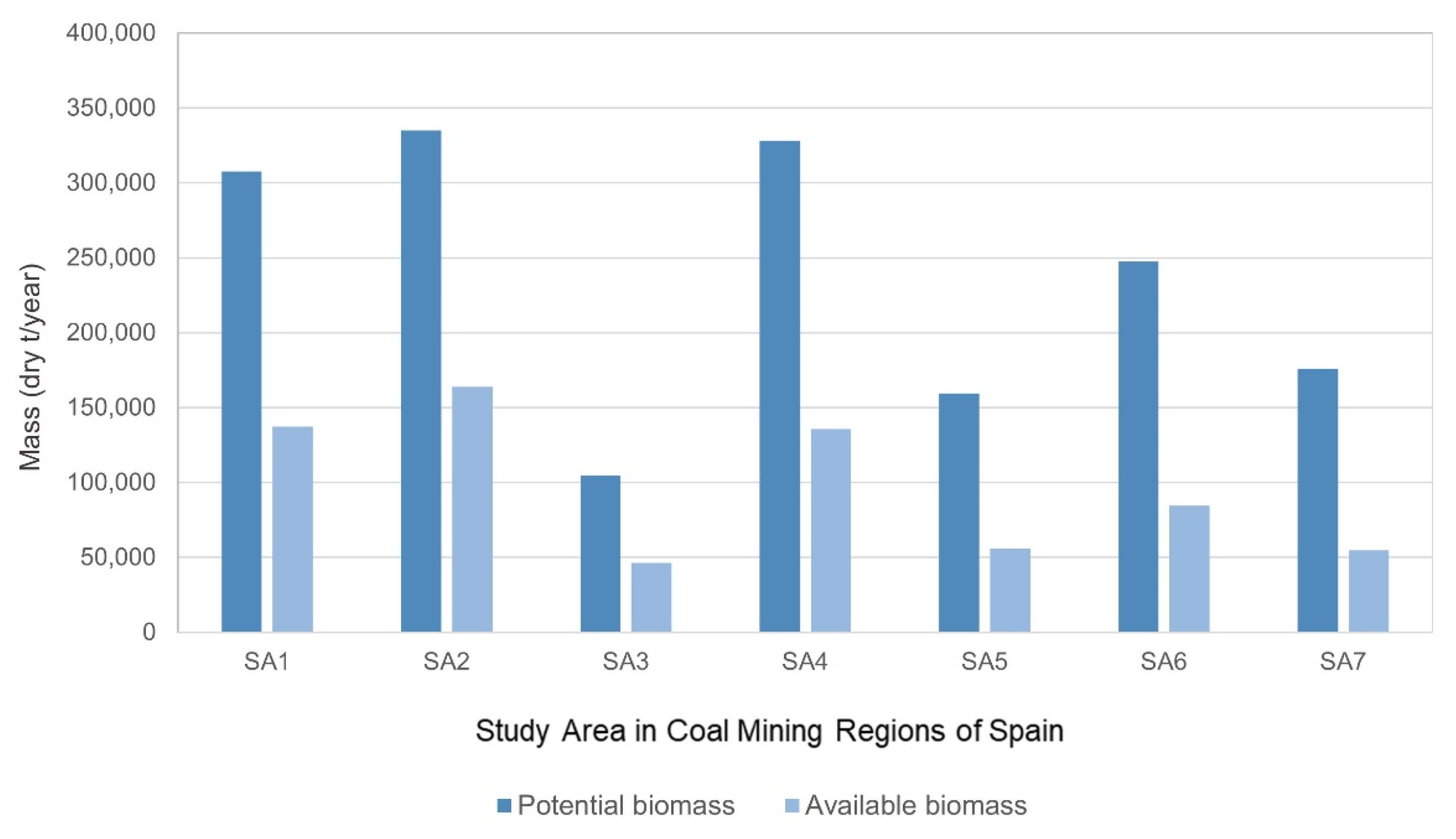


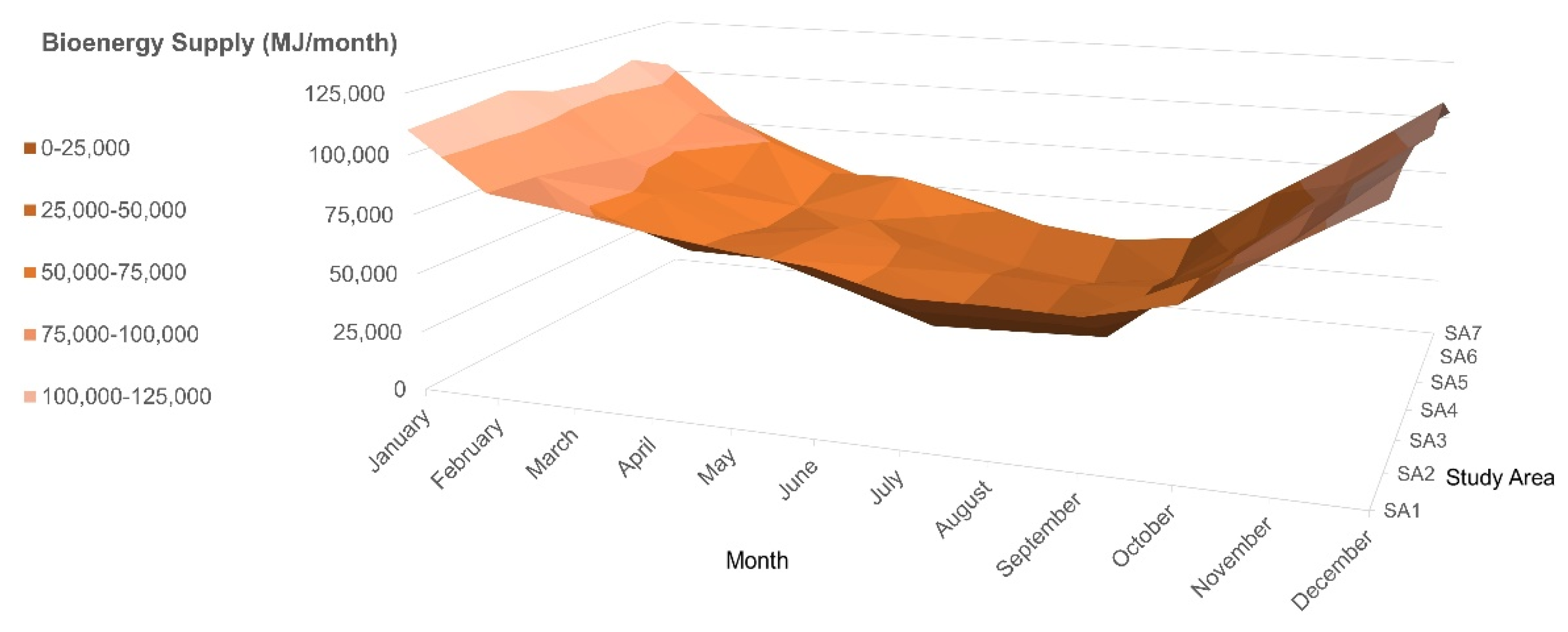

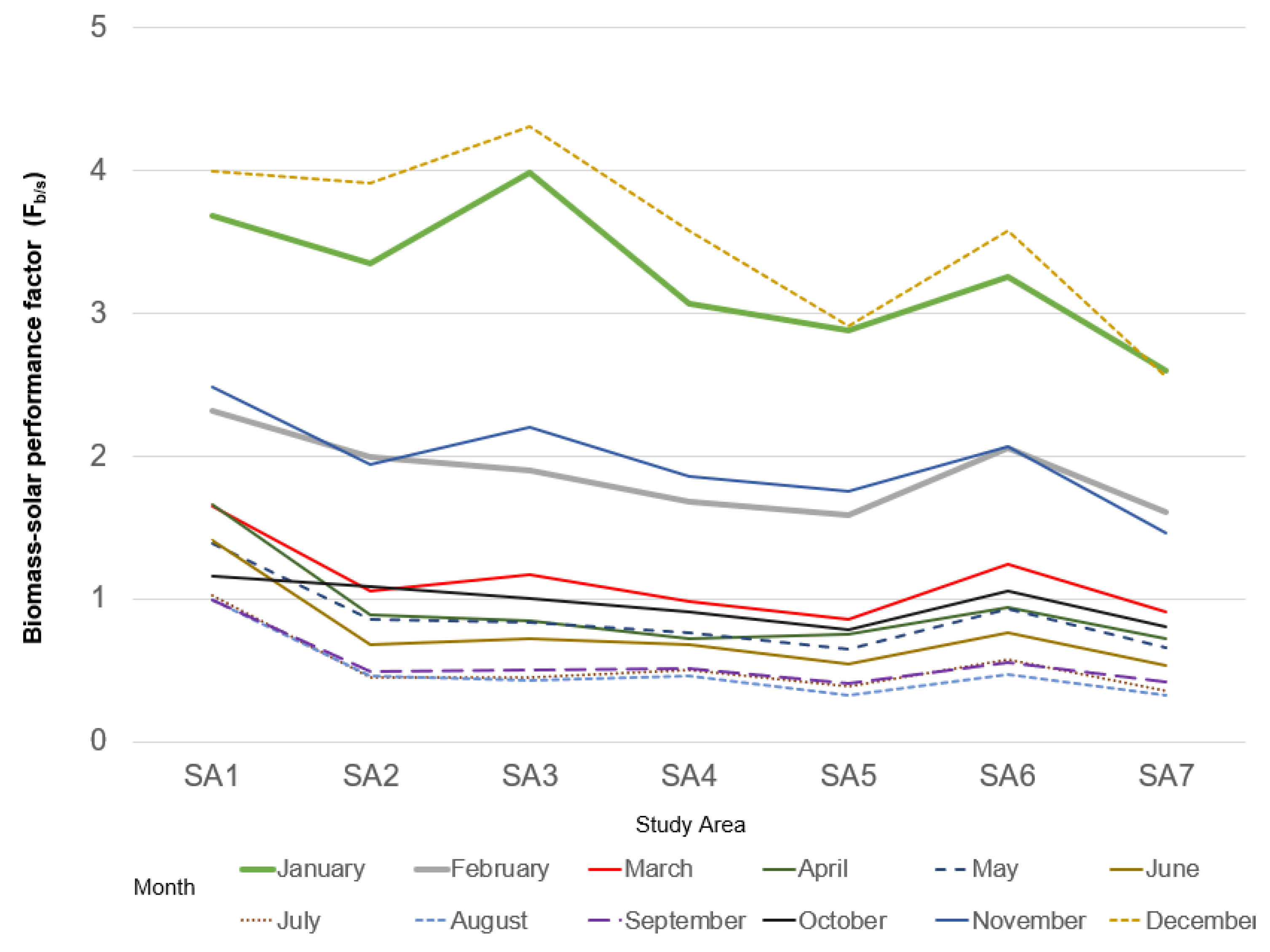
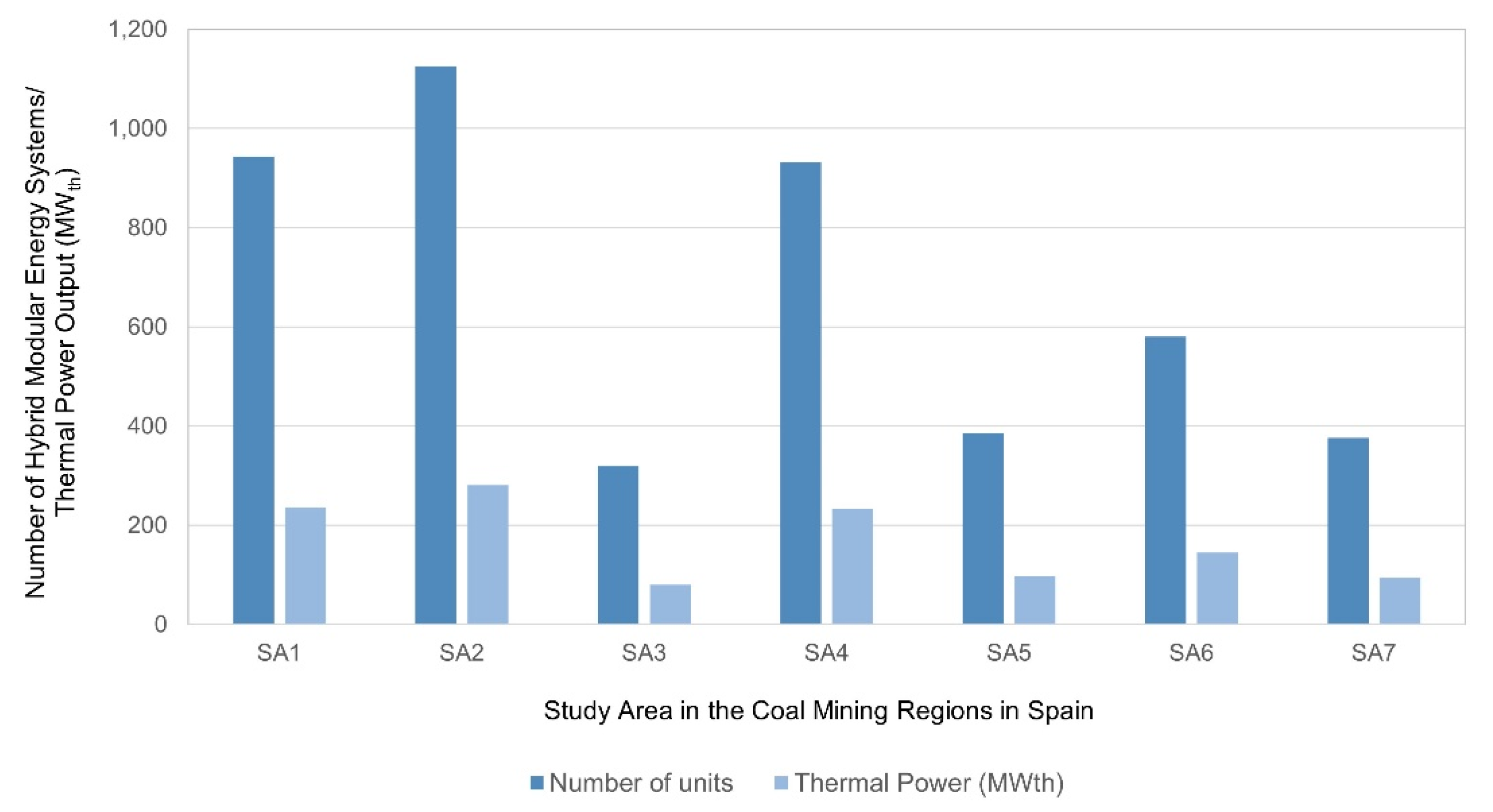

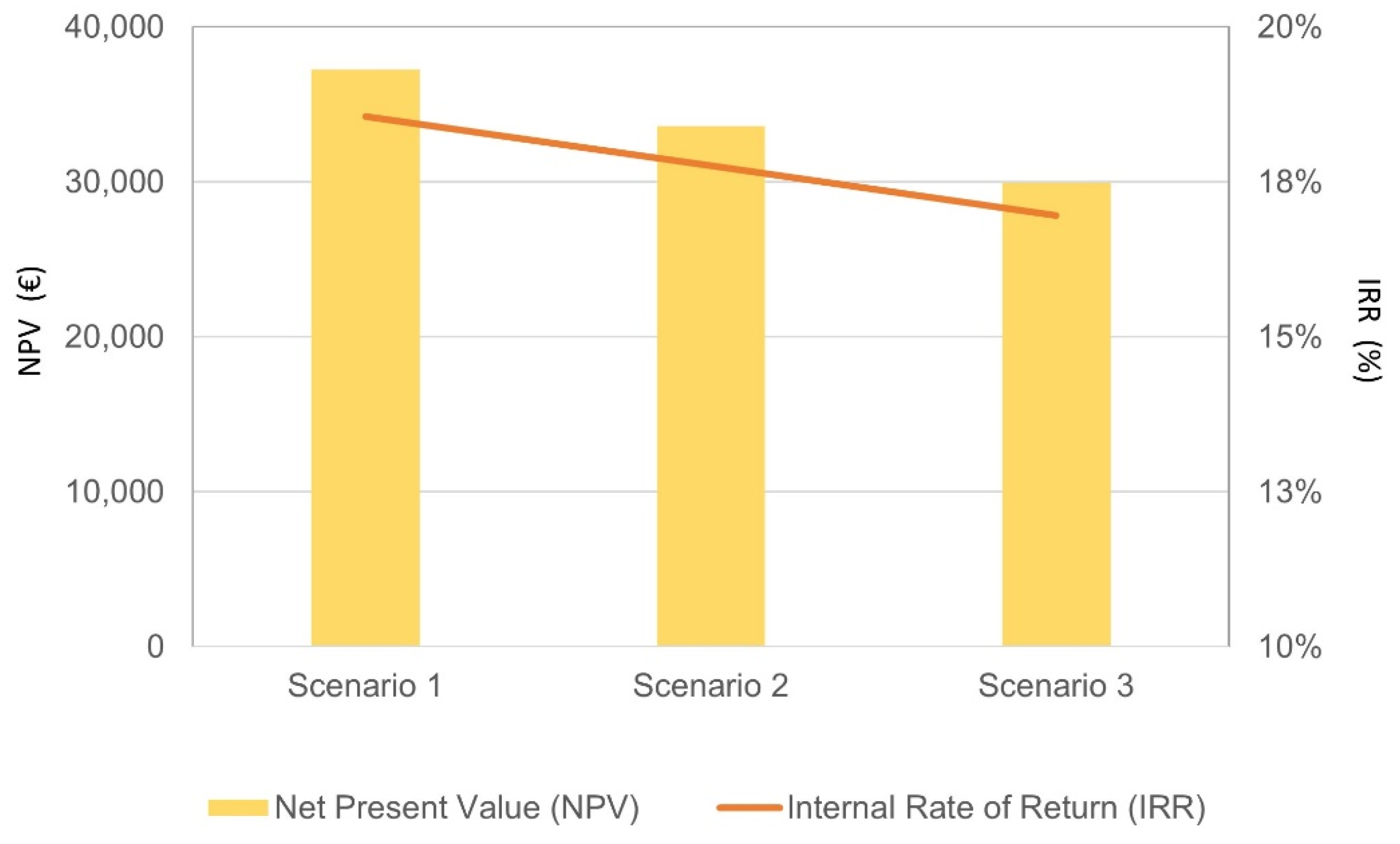
| Node Code | Name of the Sector |
|---|---|
| SA1 | Asturias |
| SA2 | Ciudad Real |
| SA3 | Huesca |
| SA4 | León |
| SA5 | Palencia |
| SA6 | Teruel |
| SA7 | Zaragoza |
| Main Operation Parameters | Load Data |
|---|---|
| Design power (kWth) | 250 |
| Biomass boiler efficiency (%) | 80 |
| Base surface of the solar collection (m2) | 250 |
| Full-load operation hours (h) | 2000 |
| Biomass/Solar coverage (%) | 70/30 |
| Parameters | Unit | Wood Fuel | Coal Fuel |
|---|---|---|---|
| Carbon | wt% | 50 | 82 |
| Hydrogen | wt% | 6 | 5 |
| Nitrogen | wt% | 0.4 | 2.1 |
| Sulphur | wt% | 0.08 | 0.90 |
| Low Heating Value (LHV) | MJ/kg | 17 | 32 |
| Parameter | Total |
|---|---|
| Income | |
| Heat price (€/kWhth) | 0.20 |
| Expenditure | |
| Biomass system (€/kWhth) | 0.12 |
| Solar system (€/kWhth) | 0.19 |
| Auxiliary systems and network (€/kWhth) | 0.23 |
| Biomass supply (€/GJ) | 5–7 |
| Operation and maintenance (€/(kWhth·year)) | 0.09 |
| General expenses (€/(kWhth·year)) | 0.02 |
| Other (€/(kWhth·year)) | 0.01 |
| Valuation Parameters | |
| Time Period (year) | 15 |
| Discount rate (%) | 10 |
Publisher’s Note: MDPI stays neutral with regard to jurisdictional claims in published maps and institutional affiliations. |
© 2021 by the authors. Licensee MDPI, Basel, Switzerland. This article is an open access article distributed under the terms and conditions of the Creative Commons Attribution (CC BY) license (https://creativecommons.org/licenses/by/4.0/).
Share and Cite
Paredes-Sánchez, B.M.; Paredes-Sánchez, J.P.; García-Nieto, P.J. Evaluation of Implementation of Biomass and Solar Resources by Energy Systems in the Coal-Mining Areas of Spain. Energies 2022, 15, 232. https://doi.org/10.3390/en15010232
Paredes-Sánchez BM, Paredes-Sánchez JP, García-Nieto PJ. Evaluation of Implementation of Biomass and Solar Resources by Energy Systems in the Coal-Mining Areas of Spain. Energies. 2022; 15(1):232. https://doi.org/10.3390/en15010232
Chicago/Turabian StyleParedes-Sánchez, Beatriz M., José P. Paredes-Sánchez, and Paulino José García-Nieto. 2022. "Evaluation of Implementation of Biomass and Solar Resources by Energy Systems in the Coal-Mining Areas of Spain" Energies 15, no. 1: 232. https://doi.org/10.3390/en15010232





